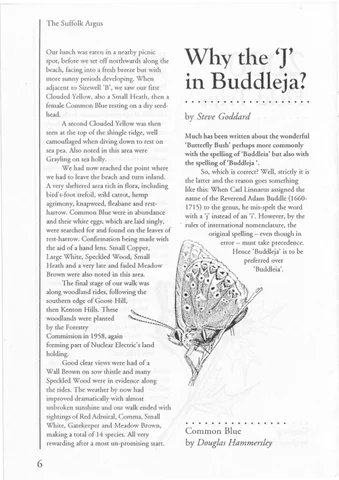The Suffolk Argus
Our lunch was eaten in a nearby picnic spot, before we set off northwards along the beach, facing into a fresh breeze but with more sunny periods developing. When adjacent to Sizewell 'B', we saw our first Clouded Yellow, also a Small Heath, then a female Common Blue resting on a dry seedhead. A second Clouded Yellow was then seen at the top of the shingle ridge, well camouflaged when diving down to rest on sea pea. Also noted in this area were Grayling on sea holly. We had now reached the point where we had to leave the beach and turn inland. A very sheltered area rich in flora, including bird's-foot trefoil, wild carrot, hemp agrimony, knapweed, fleaba.ne and restharrow. Common Blue were in abundance and their white eggs, which are la.id singly, were searched for and found on the leaves of rest-harrow. Confirmation being made with the aid of a hand lens. Small Copper, Large White, Speckled Wood, Small Heath and a very late and faded Meadow Brown were also noted in this area. The final stage of our walk was along woodland rides, following the southern edge of Goose Hill, then Kenton Hills. These
Summer 2001
Why the
in Buddleja? by Steve Goddard Much has been written a.bout the wonderful 'Butterfly Bush' perhaps more commonly with the spelling of'Buddleia.' but also with the spelling of'Buddleja ', So, which is correct? Well, strictly it is the latter and the reason goes something like this: When Carl Linnaeus assigned the name of the Reverend Adam Buddle (16601715) to the genus, he mis-spelt the word with a 'j' instead of an 'i'. However, by the rules of international nomenclature, the original spelling- even though in error - must take precedence. '·· \~~'. Hence 'Buddleja' is to be ~r...~:;. .. preferred over ,,.,.. 'Buddleia'.
The Clouded Yellowin Suffolk:2000 by Richard Stewart (Suffolk County Butterfly Recorder) For Clouded Yellow 2000 Tetra.d Map
see Pages 12-13.
..,\
·h
'f\1
.a
.\·
woodlands were planted ~~-'\ by the Forestry ~'Commission in 1958, again : . ) .. forming part of Nuclear Electric's land '....,l~·•" holding. Good clear views were had of a Wall Brown on sow thistle and many Speckled Wood were in evidence along the rides. The weather by now had improved dramatically with almost unbroken sunshine and our walk ended with sightings of Red Admiral, Comma, Small White, Gatekeeper and Meadow Brown, Common Blue making a total of 14 species. All very rewarding after a most un-promising start. by Douglas Hammersley
6
'J'
Clouded Yellow by Beryl Johnson
It is difficuJt to refer to a record year for a species of butterfly witl1 complete certainty, since modern detailed recording is a relatively new mechanism. However, the previous years when detailed recording was used for the Clouded Yellow produced coverage of 113 2 km. tetra.ds in 1996 and 119 in 1983. The year 2000 easily exceeded these, with 161 tetra.ds being covered. There is a noticeable coastal concentration of records from Southwold down to La.ndguard though the coastal gaps elsewhere are surprising. As expected there is a concentration in and a.round Ipswich, Clouded Yellows probably following the Orwell in from the coast and here there is the greatest concentration of recorders. The concentration of West Suffolk records in cl1eextensive King' Forest again probably reflects the number of recorders but for the whole of the TL tetrads the total was just 46, i.e. 28.6% of cl1ecounty total. This is probably consequent on reduced recording here, as already indicated in the 2000 Butterfly Report. The Clouded Yellow was recorded on all but one of the current transects and ~ total of 112 recorders were involved out of 179 submitting records. These include late ones received after recent publicity, and this represents 62.5% of all Suffolk butterfly recorders seeing the Clouded Yellow in 2000. The total number for 2000 was 1048 and a monthly analysis follows. Weather comments come from the monthly summary by Ken Blowers in the EADT:
19



